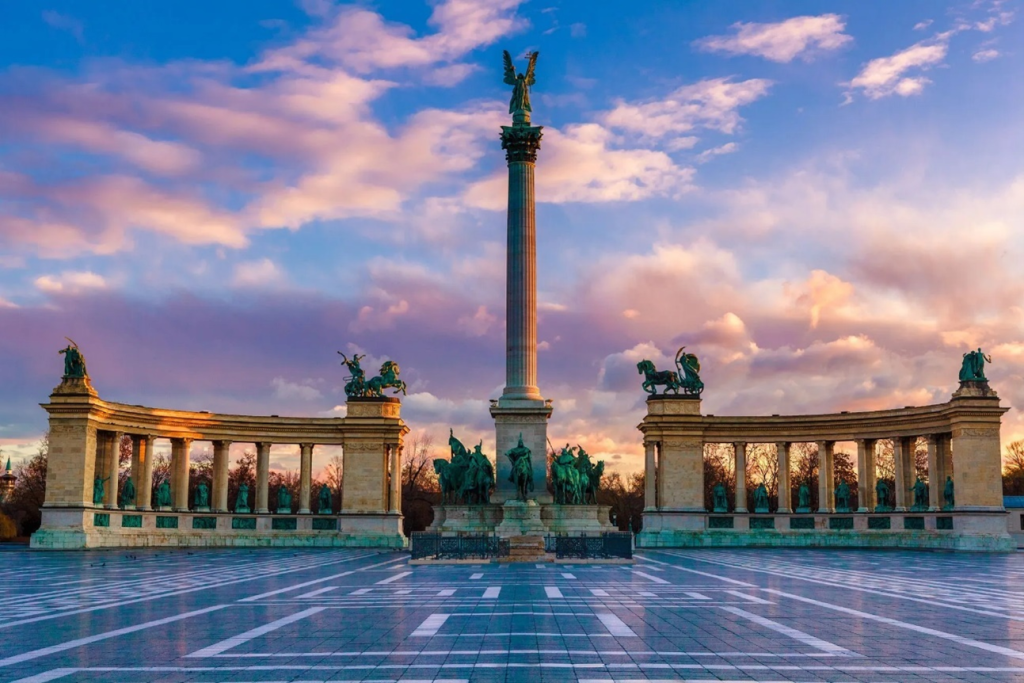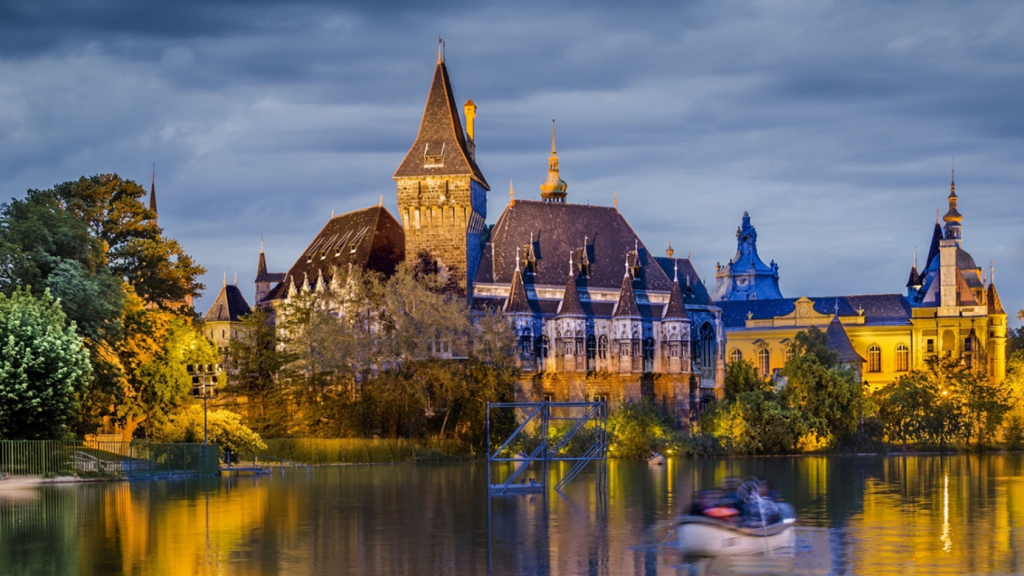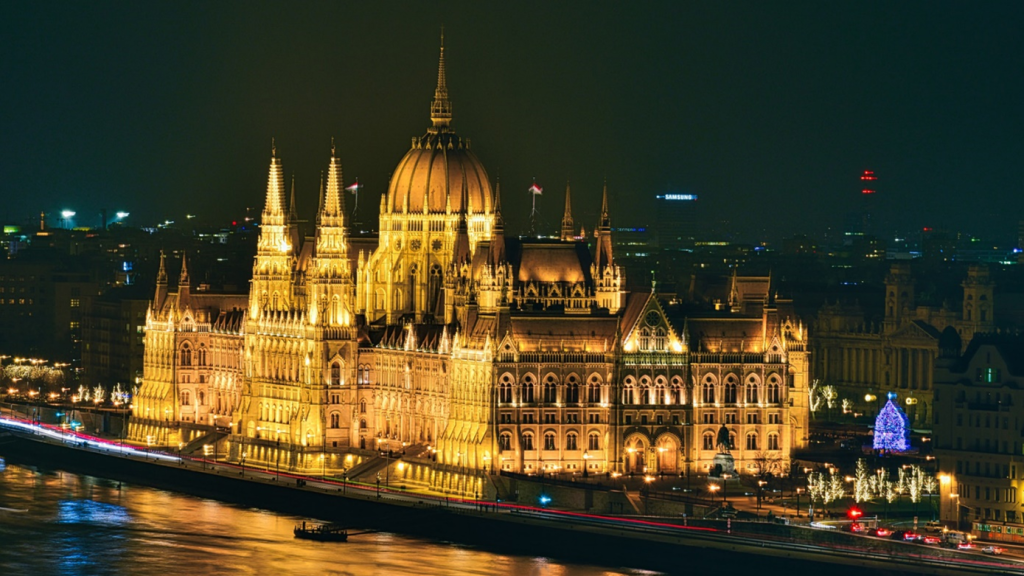Located at the end of Budapest’s iconic Andrássy Avenue, Heroes’ Square (Hősök tere) stands as a grand testament to Hungary’s rich history and its enduring spirit. This monumental square, completed in 1896 to commemorate the millennium of the Hungarian conquest of the Carpathian Basin, is one of the city’s most iconic landmarks and a UNESCO World Heritage Site.
The focal point of Heroes’ Square is the Millennium Monument (Milleniumi emlékmű), crowned by a towering column with the Archangel Gabriel holding the Hungarian Holy Crown and a double cross. At the base of the column, statues of the seven chieftains of the Hungarian tribes—who led their people into the Carpathian Basin in 895 AD—capture the essence of Hungary’s early history. Flanking the square are two semicircular colonnades adorned with statues of key historical figures, from Saint Stephen, Hungary’s first king, to Lajos Kossuth, a leader of the Hungarian Revolution in 1848-1849.

Adjacent to the square, the Museum of Fine Arts (Szépművészeti Múzeum) and the Hall of Art (Műcsarnok) provide a haven for art lovers, showcasing masterpieces from Hungary and beyond. These institutions offer visitors a deeper understanding of the cultural and artistic heritage of the nation.
Just behind Heroes’ Square lies City Park (Városliget), one of Budapest’s largest and most beloved green spaces. Spanning over 100 hectares, the park is a perfect blend of nature, leisure, and cultural attractions. Originally developed in the early 19th century, City Park was Europe’s first public park designed for recreational use. Today, it’s a hub of activity for locals and tourists alike.
At the heart of the park, the Vajdahunyad Castle (Vajdahunyad vára) enchants visitors with its eclectic mix of architectural styles, from Romanesque to Gothic, Baroque, and Renaissance. Built for the 1896 Millennium Exhibition, it’s now home to the Hungarian Agricultural Museum (Magyar Mezőgazdasági Múzeum). Another highlight is the Széchenyi Thermal Bath (Széchenyi Gyógyfürdő), one of the largest spa complexes in Europe, offering year-round relaxation in its thermal pools.

City Park also features a boating lake that transforms into a magical ice skating rink during winter, the Budapest Zoo and Botanical Garden (Állatkert), and the recently renovated House of Music Hungary (Magyar Zene Háza), a striking modern building that celebrates music and creativity.
Whether you’re seeking historical insight, cultural enrichment, or peaceful green spaces, Heroes’ Square and
City Park offer an unforgettable glimpse into the heart and soul of Budapest.
The Hungarian Parliament and the Danube Riverbank: Gems of Budapest
The Hungarian Parliament Building (Parlament) and the Danube Riverbank (Duna-folyó) together form one of the most breathtaking urban landscapes in Europe. Located in the heart of Budapest, this iconic pairing offers visitors a glimpse into the city’s rich history, stunning architecture, and vibrant cultural life.
The Hungarian Parliament Building (Országház) is the crown jewel of Budapest’s architectural heritage. Completed in 1904, it stands as one of the largest and most magnificent parliamentary buildings in the world. Its design, inspired by the Gothic Revival style with elements of Renaissance and Baroque, showcases intricate details and a striking symmetry. The central dome, rising 96 meters above the city, symbolizes the year 896 AD, marking the arrival of the Hungarian tribes in the Carpathian Basin. The Parliament’s riverside façade is adorned with statues, spires, and decorative motifs that captivate visitors from every angle.
Inside, the building is just as impressive. Guided tours reveal opulent interiors, including the main staircase, the Dome Hall where the Holy Crown of Hungary (Szent Korona) is displayed, and chambers adorned with frescoes, stained glass, and gilded ornamentation. The Parliament is not just a symbol of Hungarian democracy but also a masterpiece of national pride.

Stretching alongside the Parliament, the Danube Riverbank (Duna-part) is a UNESCO World Heritage Site and a highlight of any trip to Budapest. The river divides the city into its historic halves: Buda, with its rolling hills and medieval Castle District, and Pest, home to lively boulevards and cultural landmarks. Walking along the promenade offers postcard-perfect views of both sides, especially at sunset when the city glows in hues of gold and amber.
A must-see along the riverbank is the Shoes on the Danube Bank Memorial (Cipők a Duna-parton), a poignant tribute to the victims of World War II. This simple yet powerful installation of cast-iron shoes serves as a reminder of the lives lost during a dark chapter in history.
Visitors can also enjoy the Danube from the water itself. River cruises provide an unforgettable perspective of the Parliament, Buda Castle, the Chain Bridge, and Gellért Hill, all beautifully illuminated at night.
Whether you’re exploring the grand halls of the Parliament, strolling along the Danube promenade, or taking in the views from a riverboat, this area encapsulates the essence of Budapest: a city where history, beauty, and culture converge.
